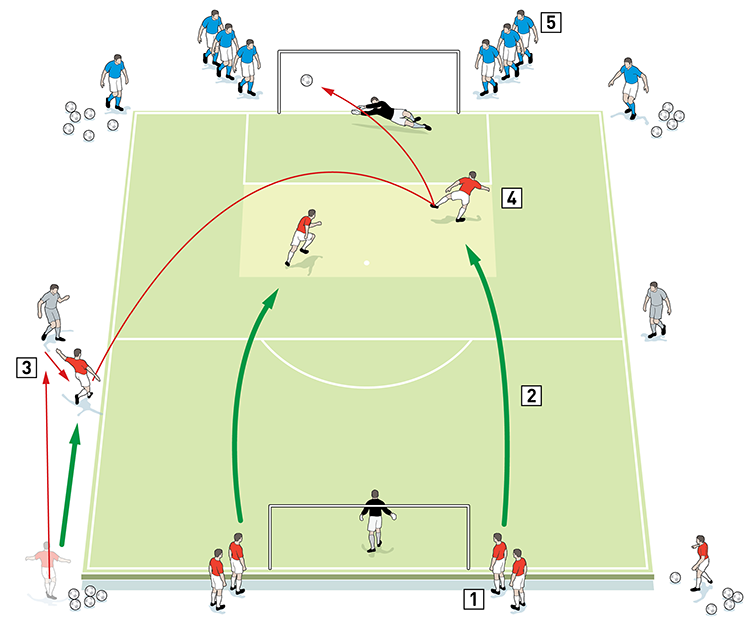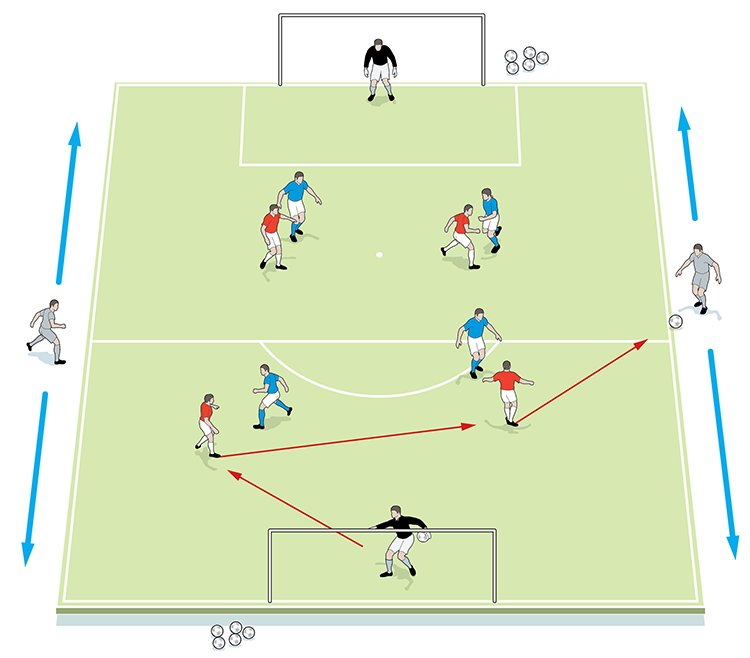You are viewing 1 of your 1 free articles
Crossing and finishing
No matter how good you are as an attacking player, you’ll always need great service, and that’s what this session coaches, notably in practising crossing situations from in and around the box.
| Area | Use of a half pitch |
| Equipment | Balls, cones, flat cones, goals |
| No. of Players | 7v7 plus keepers |
| Session Time | 6x4mins, with 1min rest in between |
Scoring goals is the hardest part of the game, in my opinion, which is why we are all looking for forwards who put the ball in the back of the net on a regular basis. But no matter how good you are as an attacking player, you’ll always need great service, and that’s what this session coaches, notably in practising crossing situations from in and around the box.
With that in mind, it involves working on delivery areas, the quality of the cross, and the runs and finishes required in key areas in front of goal.
I believe the session is enjoyable and engaging, and encourages the development of the players and the team by highlighting areas that we feel can be exploited from out wide areas in a match.
This is a set-up we’ll visit quite often as it is enjoyable and it is always relevant to a match on the weekend. And as you would expect, repetition improves the quality and the understanding of the cross, not to mention the runs and finishes required.
What do I get the players to do?
Phase One: crosses from outside
We set up, as shown (1), using two 18-yard boxes. The players attacking the crosses will be in pairs at the side of either goal, with a further six on the outside of the 18-yard boxes, one in each corner and one either side of the halfway line.
In the first phase, we’re looking for wide players to cross from outside/deeper than the penalty spot, putting the ball into the area where an imaginary second six-yard box would be. Forwards are encouraged to make runs to the near post and the middle of the goal.
1

2. Forwards make for near- and far-post areas
3. In the first attack the cross comes from behind/deeper than the penalty spot
4. The cross ends with an attack on goal
5. Now an attack configured in the same manner will start from the opposite end
Phase Two: crosses from inside
In the second phase we are looking for the wide players to be crossing from inside/further than the penalty spot, delivering the ball to around the back post area or cutting it back to the penalty spot, as shown (2). The forwards will subsequently have to adjust their runs to these areas.
2

2. This time the cross is taken further up the line
3. The cutback to the penalty spot is finished by the advancing attackers
How do you progress the session?
In phases three and four we run just as we did for phases one and two except we now add mannequins in to each challenge (3). And progressing again after that, we re-run the initial two phases again but subsequently add a defender in to each scenario.
3

How do I put this into a game situation?
In the game situation we use the same area but set up as a 5v5 including keepers, as shown (4). It’s two players from each team in each half, with neutral wide players who stimulate, facilitate and contribute to the attacks of the team in possession. One wide player can be active during an attack so as to create a 3v2 attacking overload.
4

What are the key things to look for technically and tactically?
In every phase, wide players need to understand the areas to deliver to in relation to where they have the ball on the pitch. They then need to have the required quality to deliver the ball regularly into these areas, and that can only come with repetition and awareness of team mates’ movements.
Forwards need to have an understanding of the runs required, the areas where the ball is most likely to be delivered, the timing of their own runs and the need for a quality finish, usually under pressure. Forwards should also consider the fact that runs will often be made simply for the purpose of drawing defenders away from them, and not always with the expectation of the ball arriving to them.
To instill a competitive mindset, we will frequently remind defenders and keepers of their desire never to concede goals. Sometimes just reminding players of this can make a practice more realistic as it focuses the playing intention.
It’s important to note too - I believe a cross is still a pass but all too often it is played in with too much pace. Therefore, I will always encourage balls into the middle to be of the quality expected in a pass and, where practical and possible, with the same pace.
Related Files
More like this
Editor's Picks
Deep runs in the final third
Using the goalkeeper in build-up play
Pressing principles
Intensive boxes drill with goals
Penetrating the final third
Creating and finishing
My philosophy
Pressing initiation
Compact team movement
Coaches' Testimonials

Alan Pardew

Arsène Wenger

Brendan Rodgers

Carlos Carvalhal

José Mourinho

Jürgen Klopp

Pep Guardiola

Roy Hodgson

Sir Alex Ferguson

Steven Gerrard
Coaches' Testimonials

Gerald Kearney, Downtown Las Vegas Soccer Club

Paul Butler, Florida, USA

Rick Shields, Springboro, USA

Tony Green, Pierrefonds Titans, Quebec, Canada
Join the world's leading coaches and managers and discover for yourself one of the best kept secrets in coaching. No other training tool on the planet is written or read by the calibre of names you’ll find in Elite Soccer.
In a recent survey 92% of subscribers said Elite Soccer makes them more confident, 89% said it makes them a more effective coach and 91% said it makes them more inspired.
Get Monthly Inspiration
All the latest techniques and approaches
Since 2010 Elite Soccer has given subscribers exclusive insight into the training ground practices of the world’s best coaches. Published in partnership with the League Managers Association we have unparalleled access to the leading lights in the English leagues, as well as a host of international managers.
Elite Soccer exclusively features sessions written by the coaches themselves. There are no observed sessions and no sessions “in the style of”, just first-hand advice delivered direct to you from the coach.









